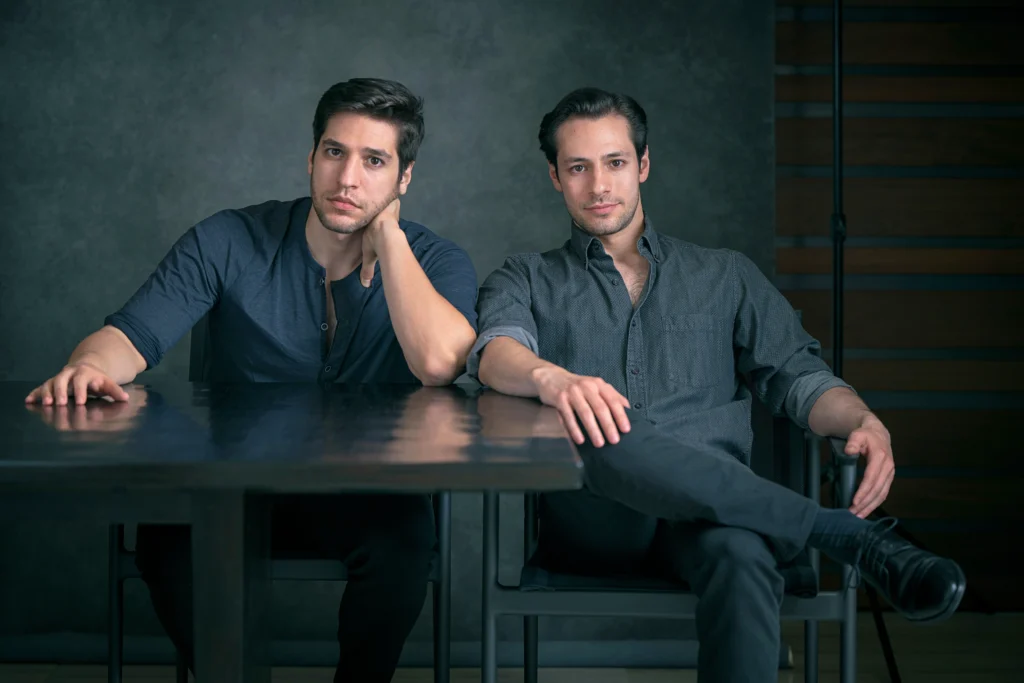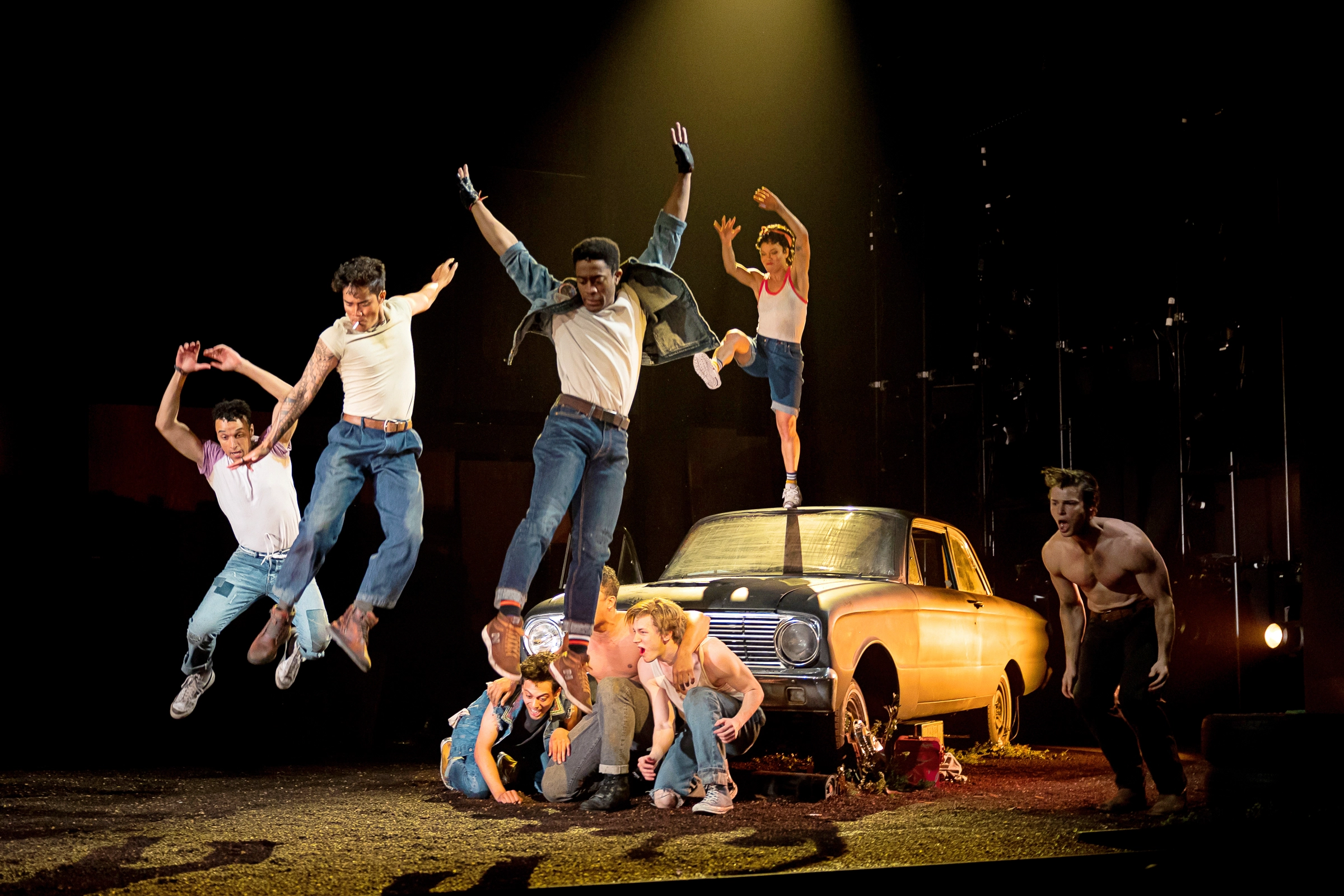Meet the Kuperman Brothers, the Sibling Duo Behind the Choreography for Broadway’s The Outsiders
Known for their witty and athletic movement style, Canadian brothers Rick and Jeff Kuperman trained as competition dancers and martial artists before launching their careers with downtown New York City shows featuring, as Rick puts it, “very small budgets and huge amounts of collaboration and creativity.” They’ve since choreographed off-Broadway productions of Cyrano and Alice by Heart (the latter earned them a Drama Desk nomination), as well as last year’s A24 film Dicks: The Musical. Still, that downtown scrappiness is a mainstay of their mindset and aesthetic, making them the ideal choreographic match for The Outsiders, a new Broadway musical based on the book by S.E. Hinton and film of the same name, about a group of teen outcasts—including a trio of, yes, brothers—in 1967 Tulsa.
The Outsiders is one of the most widely assigned pieces of required reading in American schools, as well as a touchstone film of the 1980s. What was your relationship to it prior to your work on the musical?
Jeff: I read it in middle school, and it was one of the first books that really moved me emotionally as a kid. So when the script hit our desk, I was super-excited to dive into it. Especially with the themes of brotherhood so entrenched in the book, I thought this would be a great piece for Rick and me to handle.
Rick: I missed the memo because I actually had never heard of this story. My first touchpoint with the project was Adam [Rapp]’s script. I was a big fan of Adam’s writing and had studied a lot of his plays in college. It was cool to be introduced to the world of The Outsiders through his eyes. It’s very visceral and hard-hitting, and that really resonated with me.

You mentioned brotherhood as a key theme in the story. How did being a choreography team help you develop the movement for the show?
Rick: Choreography does a lot of the world-building in The Outsiders. There’s social dance in the world, and there’s a lot of fight choreography. Having a partner to be able to first create the material on is super-important and helps make that choreography three-dimensional.
Jeff: Rick and I studied martial arts as kids and through college. The martial aspect of the choreography is something that you have to do with a partner. We are really interested in the use of force—not faking force, but redirecting force and momentum. You can’t do that alone. It’s good to have a brother you’re not afraid to roughhouse with. It’s kind of an essential piece of this choreography.
I imagine that looks and feels a little bit different than the major fight sequence in the film.
Rick: We’re working in a different medium. In the theater, we need to use a different set of tools to make the fight evocative, and one of the ways that we’ve thought to do that is to really stylize or render the fight in a more expressionistic mode than pure realism.
Jeff: One of the lines that really stuck out to me, upon my first read of the script, was “the fists detonate into the boys’ flesh.” That idea of detonating into flesh sparked an idea about sound design and how so much of the way that we interpret violence when we see it is aurally, actually, and so that was the jumping-off point for us when we started to create the rumble.
Rick: Right. It’s the climax, so every department—scenery, lighting, choreography, sound design, all of it—is hopefully acting in unison to render this climactic moment for the story.
The Outsiders is set in 1967. How did that influence the choreography?
Jeff: While we’re confronting some difficult truths about the past and the present, there is a very real sense of love throughout. But it was a fraught period politically and racially, and we’re not shying away from that, especially in the rumble. We’re trying to lean into choreographic metaphor for the cyclicality of violence that we’re trapped in, and we’re examining how we break that cycle lest it continue to consume us.
So many of these characters, especially the Greasers, have such a real love for each other, but they don’t have the vocabulary with which to express it. So it’s expressed physically, it’s expressed through play, it’s expressed through violence.
The Greasers move very differently from the Socs. The Socs are a little bit more put-together, and their lines are a little bit straighter, a little bit more refined, and the Greasers have a much more hard-hitting edge to them. A great joy of this project has been leaning into the individualism of each performer, allowing them to really carve their own track through this show. Their fingerprints are all over this thing, and we wouldn’t have it any other way. Because one of the main themes of the show is: How does an individual retain that core essence of themself even when they’re amongst a group of like-minded individuals?
The choreography’s interaction with the set—the physical space, the objects—how did that come together?
Jeff: The very first workshop where The Outsiders was put up on its feet, we didn’t have very much. I think we had a couple of rolling boxes, a couple of theater cubes, a few very specific props. But we ended up staging so much, using sound and music and boxes, just to see what it might feel like in a black-box theater, and a lot of that ethos carried over into the production.
What are your favorite numbers from the show?
Jeff: My favorite traditional number is probably “Grease Got a Hold on You.” It’s Ponyboy’s induction into the gang of Greasers and his anointment, so to speak, as they put grease in his hair for the first time and say “You’re truly part of us.” It’s an opportunity for each of the Greasers to give the audience a taste of who they are, what makes them special—and we get to express that through how they move.
Rick: A lot of the tentpoles are really special to us: the rumble, the fire, and a piece called “Run, Run, Brother,” which is the closer of Act I. But there’s also a really short number called “Trouble” right before the rumble, and it’s really succinct. The way that Susie describes this moment in the book is that firstly, everyone’s dressed in their Sunday best to get ready for the battle, which is just such a striking detail: These characters put on their finery only to come and do battle and stain it with blood. There’s this huge sense of energy and group identity, and I guess a form of tribalism, really, that unleashes this huge amount of physicality. In the movie, you’ll see Tom Cruise bust a backflip for what seems like no reason, but it’s grounded in the idea of just so much energy. In the book she talks about a character having trained at the YMCA in gymnastics and [teaching the others]. So “Trouble” is a little taste of some virtuosity when the Greasers coalesce as they get ready to do battle, and it’s really fun physicality in action.
What do you hope audiences take away from The Outsiders?
Rick: Ponyboy is such a resilient character. There’s so much tragedy that befalls him, and yet he makes this incredible and powerful choice to keep going, and to find beauty and optimism despite incredible challenges. We can all learn something from Ponyboy in that respect.




